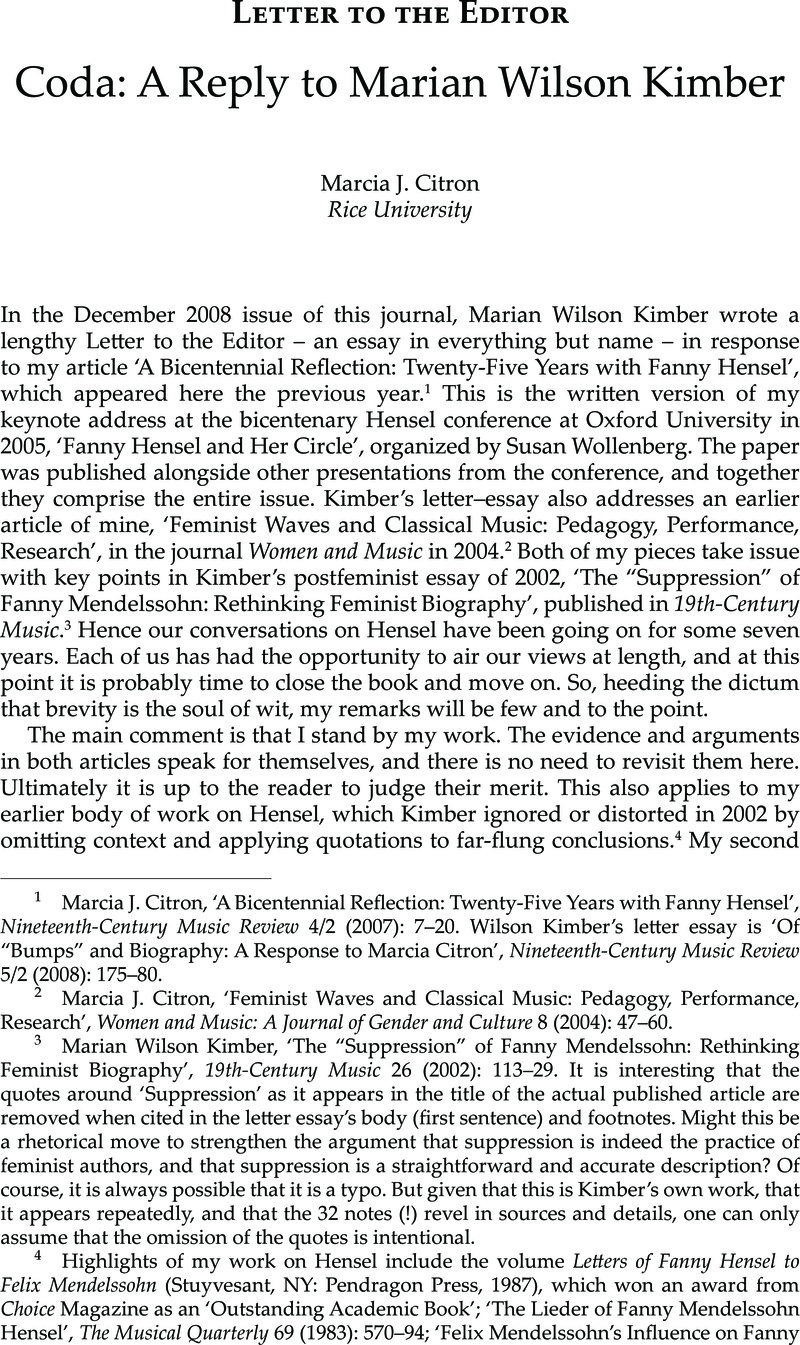Article contents
Coda: A Reply to Marian Wilson Kimber
Published online by Cambridge University Press: 13 April 2011
Abstract

- Type
- Letter to the Editor
- Information
- Copyright
- Copyright © Cambridge University Press 2009
References
1 Marcia J. Citron, ‘A Bicentennial Reflection: Twenty-Five Years with Fanny Hensel’, Nineteenth-Century Music Review 4/2 (2007): 7–20. Wilson Kimber's letter essay is ‘Of “Bumps” and Biography: A Response to Marcia Citron’, Nineteenth-Century Music Review 5/2 (2008): 175–80.
2 Citron, Marcia J., ‘Feminist Waves and Classical Music: Pedagogy, Performance, Research’, Women and Music: A Journal of Gender and Culture 8 (2004): 47–60.CrossRefGoogle Scholar
3 Kimber, Marian Wilson, ‘The “Suppression” of Fanny Mendelssohn: Rethinking Feminist Biography’, 19th-Century Music 26 (2002): 113–29. It is interesting that the quotes around ‘Suppression’ as it appears in the title of the actual published article are removed when cited in the letter essay’s body (first sentence) and footnotes. Might this be a rhetorical move to strengthen the argument that suppression is indeed the practice of feminist authors, and that suppression is a straightforward and accurate description? Of course, it is always possible that it is a typo. But given that this is Kimber’s own work, that it appears repeatedly, and that the 32 notes (!) revel in sources and details, one can only assume that the omission of the quotes is intentional.CrossRefGoogle Scholar
4 Highlights of my work on Hensel include the volume Letters of Fanny Hensel to Felix Mendelssohn (Stuyvesant, NY: Pendragon Press, 1987),Google Scholar which won an award from Choice Magazine as an ‘Outstanding Academic Book’; ‘The Lieder of Fanny Mendelssohn Hensel’, The Musical Quarterly 69 (1983): 570–94;Google Scholar‘Felix Mendelssohn's Influence on Fanny Hensel as a Professional Composer’, Current Musicology 37–38 (1984): 9–17;Google Scholar the article on Hensel for The New Grove Dictionary of Music and Musicians, 2nd ed. (London: Macmillan, 2001),Google Scholarand The New Grove Dictionary of Women Composers (London: Grove Publications, 1994); and substantial discussions in my bookGoogle ScholarGender and the Musical Canon (Cambridge: Cambridge University Press, 1993), and the article ‘Women and the Lied, 1775–1850’, inGoogle ScholarWomen Making Music: The Western Art Tradition, 1150–1950, ed. Bowers, Jane and Tick, Judith (Urbana: University of Illinois Press, 1986), 224–48.Google Scholar
5 Kimber, , ‘The “Suppression” of Fanny Mendelssohn’, 126.Google Scholar Although much of the argument is by innuendo, the lead sentence of the second paragraph is telling: ‘If feminist biography and women's history as a whole are to have any validity, they must not abandon a historical method that believes in evidence and replace it with fiction.’
6 See, for instance, the following contributions to the Oxford Conference in Nineteenth-Century Music Review 4/2 (2007):Google ScholarTodd, R. Larry, ‘Fanny Hensel’s Op. 6 #1 and The Art of Musical Reminiscence’, 89–100;Google ScholarHead, Matthew, ‘Genre, Romanticism, and Female Authorship: Fanny Hensel's “Scottish” Sonata in g minor (1843)’, 67–88;Google Scholar and the joint paper of Borchard, Beatrix and Bartsch, Cornelia, ‘Leipziger Straße Drei: Sites for Music’, 119–38.Google Scholar In addition, Todd has a blockbuster life-and-works monograph on Hensel in press (Oxford: Oxford University Press, [2009]).
- 1
- Cited by


